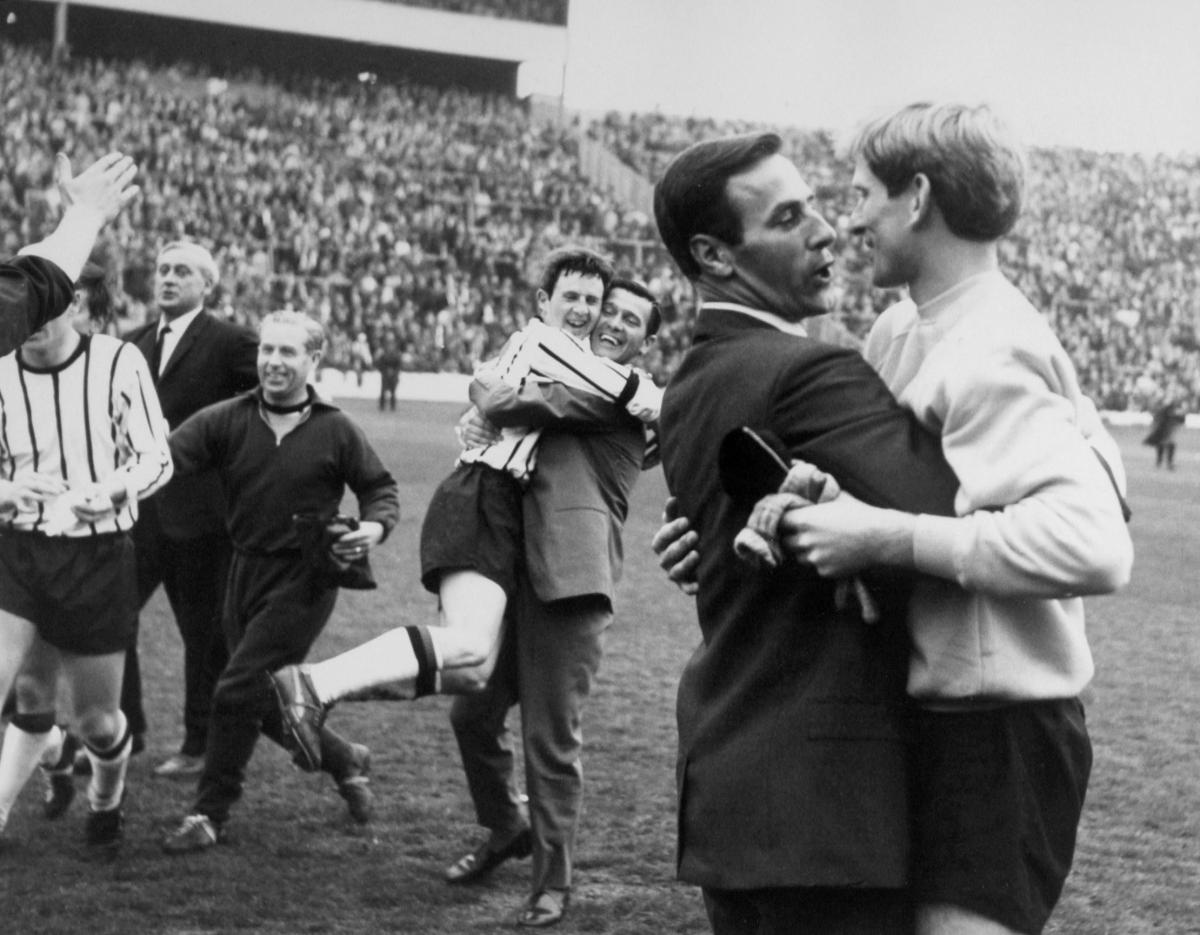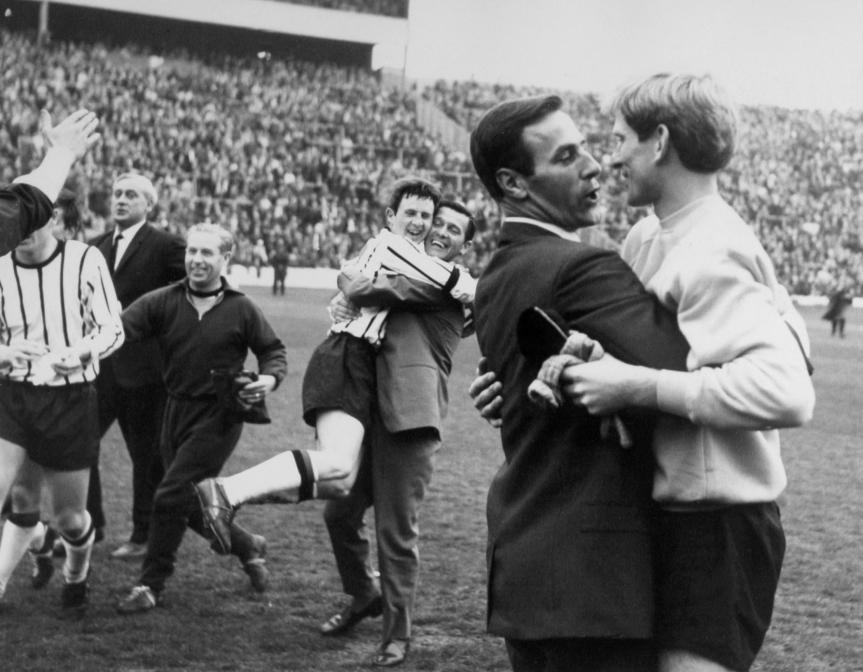
THEN, AS NOW, Celtic ruled the roost in Scotland, winning everything that came before them at home and, in the 1960s, abroad. Rangers, who had a decent team in the late 1960s were in their shadows and the rest of Scottish football could only look on and admire.
Celtic were Scottish Champions with a two-point margin over Rangers in 1967-68 with Hibernian in third place and Dunfermline fourth, some 24 points behind Celtic. In 1966-67, Dunfermline were eighth, just 20 points shy of the top spot – Celtic’s superiority was growing.
 The Pars from Fife were a good team in the mid-to-late 1960s, managed by George Farm, who took over a club that had been managed by Jock Stein between 1960 and 1964. Stein’s record at East End Park was impressive, winning the 1961 Scottish Park by beating his future employer, Celtic, at Hampden Park. It was Dunfermline’s first piece of silverware. A year later, they reached the last eight of the European Cup-Winners’ Cup and finished fourth in the league. Stein, having weaved some magic with the club, was lured away to Celtic in 1964 and Dunfermline appointed Willie Cunningham, a member of the 1961 team, as manager. He led the club to another Scottish Cup Final, but Celtic, now under the Pars’ old boss, won 3-2 with a team that would form the bulk of the famous “Lisbon Lions”.
The Pars from Fife were a good team in the mid-to-late 1960s, managed by George Farm, who took over a club that had been managed by Jock Stein between 1960 and 1964. Stein’s record at East End Park was impressive, winning the 1961 Scottish Park by beating his future employer, Celtic, at Hampden Park. It was Dunfermline’s first piece of silverware. A year later, they reached the last eight of the European Cup-Winners’ Cup and finished fourth in the league. Stein, having weaved some magic with the club, was lured away to Celtic in 1964 and Dunfermline appointed Willie Cunningham, a member of the 1961 team, as manager. He led the club to another Scottish Cup Final, but Celtic, now under the Pars’ old boss, won 3-2 with a team that would form the bulk of the famous “Lisbon Lions”.
Dunfermline had been ahead by 2-1, but match reports suggested they had been “unrealistically casual” and Celtic came back to win thanks to a goal from skipper Billy McNeill. Dunfermline almost returned to the final in 1966, losing once more to Celtic at the semi-final stage. Another good European run saw them go as far as the quarter-finals in the inter-Cities Fairs Cup.
Cunningham left in 1967 and Dunfermline hired George Farm, a former Scottish international goalkeeper, but most well known for being a member of the Blackpool team that won the FA Cup in 1953 in the famous “Matthews Final”.
Farm had experienced success with Raith Rovers and Queen of the South, taking both clubs to a promotion. Farm was something of a quirky character, but was also a canny operator, observing everything that Stein was doing at Celtic and trying to replicate that approach.
 After joining in 1967, Farm’s first league game, ironically, was against Raith Rovers and the Pars won 2-1. It wasn’t until the back end of 1967 and into January 1968 that the team clicked into gear, and at the end of January they beat Celtic 2-0 in the first round of the Scottish Cup, inflicting on the Glasgow giants their first defeat at that stage of the competition since 1952. The goals were scored by Hughie Robertson and Pat Gardner.
After joining in 1967, Farm’s first league game, ironically, was against Raith Rovers and the Pars won 2-1. It wasn’t until the back end of 1967 and into January 1968 that the team clicked into gear, and at the end of January they beat Celtic 2-0 in the first round of the Scottish Cup, inflicting on the Glasgow giants their first defeat at that stage of the competition since 1952. The goals were scored by Hughie Robertson and Pat Gardner.
With Celtic out of the way, Dunfermline met Aberdeen in round two and won 2-1, thanks to an 85th minute winner by midfielder Alex Edwards. It was another late goal, scored by Bert Paton, that secured the third round win against Patrick Thistle to put Dunfermline into the semi-final where they would meet St. Johnstone at Hearts’ Tynecastle.
It took two games for Farm’s men to overcome the Saints, a 1-1 draw being followed by a 2-1 victory. They were losing in the replay until Paton levelled and then in extra time, Ian Lister netted an 118th minute winner. Their opponents in the final would be Hearts.
Dunfermline’s team had been constructed over a few seasons. In goal, Dane Bent Martin had arrived in December 1966 from Celtic, while right back Willie Callaghan had been with the club since 1961. John Lunn, on the left side, had been picked-up from a colliery team in 1963. Lunn, sadly, died at just 26 years of age.
The skipper of the team was Roy Barry, an ex-Hearts player who would eventually try his luck in England. Also in defence was John McGarty, who would make his third first team appearance in the cup final.
One of Dunfermline’s star men was Tommy Callaghan, an elegant midfielder who could go on long, incisive runs from deep. He would later leave the club for Celtic where he struggled to be accepted.
Winger Ian Lister joined Dunfermline from Raith Rovers in mid-season but proved to be a man for the big occasion. Hughie Robertson had arrived in 1965 from Dundee, costing £13,000. He had played in the 1962 World Cup for Scotland. Midfielder Alex Edwards had been earmarked for stardom when Jock Stein was manager and as a teenager he had featured in Dunfermline’s 6-2 win against Valencia in the Fairs’ Cup in 1962. Inside forward Pat Gardner was another former Raith player who arrived at the club in 1967 for a “sizeable fee” which has been reported as being £ 17,000. Bert Paton, who had been with the club since 1961 after leaving Leeds United, had a keen eye for goal.
The final, played before just 56,000 people, came alive in the second half. Hearts had enjoyed much of the play in the first period, but Dunfermline’s swift and accurate passing movements eventually paid off. They went ahead on 56 minutes when Lister’s Free kick caused problems in the Hearts defence and there was a mix-up as keeper Jim Cruickshank knocked the ball out to Gardner who hooked it home with his left-foot into the net. Four minutes later, it was 2-0 as Lister scored from the penalty spot after Cruickshank had sent Paton flying in the area.
Hearts were given a lifeline by an own goal from Lunn, but then Gardner scored another goal from close range to wrap things up at 3-1. Strangely, there was some ill-feeling in the celebrations when Dunfermline were not allowed to show the cup to their fans.
The good times didn’t end there, however, for in Europe in 1968-69, Dunfermline reached the semi-finals of the European Cup-Winners’ Cup, beating Apoel of Cyprus, Olympiacos of Greece and English FA Cup winners West Bromwich Albion. They eventually went out to Slovan Bratislava 2-1 on aggregate. In the league, they finished third that season but in 1972 they were relegated. Life has never been as good for the Pars, but the heroes of 1968 will never be forgotten at East End Park.

